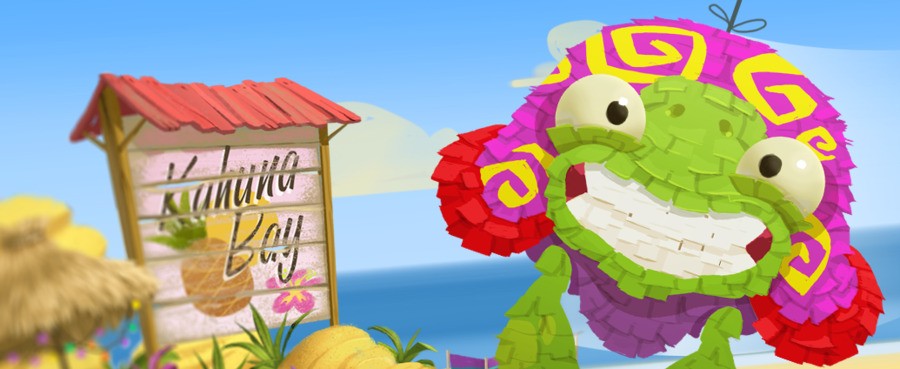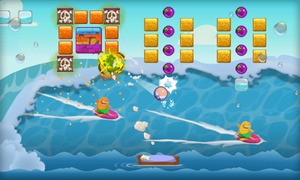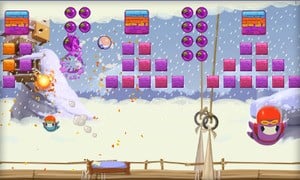
While much recent attention has focused on titles on the way to the Wii U eShop, we shouldn't forget that the 3DS store has a prominent role to play in the coming months and years. We've gradually seen the library grow, with plenty of developers using the portable system as their point of entry into publishing on Nintendo hardware.
Another developer doing just that is Mojo Bones, a studio that's released multiple titles — and achieved some notable success — on smartphone platforms, but is now preparing to make its 3DS début in Q1 2014. It's bringing Siesta Fiesta to the eShop, a title that seeks to incorporate classic ideas with fresh gameplay — it's promising enough that Nintendo has published a trailer and put the game on show at the recent IndieCade event.
To learn more about this game we've had a chat with designer Stuart Ryall, who also provided some rather tasty exclusive screens for you to enjoy.

Nintendo Life: For anyone that may be unfamiliar with your company, can you tell us more about Mojo Bones?
Stuart Ryall: Mojo Bones opened its doors in 2011 and we’re a small, independent studio based in the U.K. Our team has a long history of working in the industry - across multiple genres and platforms - and Siesta Fiesta marks our Nintendo 3DS debut. Exciting times!
NL: Siesta Fiesta seems to be a sidescrolling, modern take on arcade classic Breakout, is that an accurate description?
SR: Definitely. As well as the obvious Breakout/Arkanoid influence, Siesta Fiesta has been heavily influenced by classic platformers, arcade pinball and physics-based puzzlers.
NL: Can you explain the reasoning and inspiration for tackling this game style?
SR: Our aim has always been to try and create fun, accessible games with a twist. Sometimes that twist might be an interesting art style, lead character or game mechanic. In the case of Siesta Fiesta, we were interested in taking some of our favourite games (classics that we’ve grown-up playing) and combining them to try and create something fresh. A modern-day mash-up.
We’re also interested in developing games that can be appreciated by a broad audience. I look at games like Tetris, Guitar Hero, Peggle as a few examples of games that can literally be played by anyone, but the genius is in their depth: they can be enjoyed by all skill levels. Nintendo are another obvious inspiration when it comes to trying to form that perfect balance.
So overall, we hope that players find Siesta Fiesta intuitive and fun on a casual level, but we really hope they keep coming back for more.
NL: Your game details promise over 55 levels and various interactive objects; can you tell us about some of the tricks and ideas that'll keep the concept fresh through the whole experience?
SR: We have a really simple game mechanic which involves keeping Siesta airborne. You use the bed to bounce him and tap the screen at the moment of impact to give him a speed boost. This enables Siesta to reach higher parts of the world and earn bigger scores. Your main objective is to score as many points as possible and achieve a gold medal for each stage. Combos and bonuses will allow players to fight for higher scores.
But ultimately, the variation comes from the things Siesta interacts with: this is where the platforming inspiration is important.
As we showed in the trailer, there are the large/small Piñata blocks, grape collectables and bumpers – which people will hopefully find fun in their own right – but every region also comes with its own unique contraptions. As the game progresses we end up with a palette of objects to have fun with.
For example: we have the Fire Piñatas which spawn fireballs when hit and can be used to trigger other blocks and bonuses. It’s even possible for a fireball to trigger another Fire Piñata, allowing for some high-scoring chain-reactions. We have Fan Blocks which will blow Siesta off-course, Party Gates – which require accuracy to bounce through – Party Drums that ping Siesta in fun patterns, Neon Blocks that illuminate and lots more.
Power-ups will also play a part. We have the Fiesta Crates (allowing Fiestas to be juggled alongside Siesta - think multi-ball), Flame Crates (letting Siesta smash through Piñata Blocks without rebounding) and we also have some other add-ons that we’re holding back for now.
Each of Fiestaville’s 8 regions will also have its own Piñata Boss. These act as time-attack levels, and require players to finishing them as quickly as possible.
Siesta Fiesta is locked at 60fps, which is something we felt strongly about, so there’s a challenge in creating a frantic, physics-based game whilst keeping the gameplay smooth.
And finally, we have the island of Fiestaville itself. Each of the 8 regions has its own party theme and accompanying Fiestas. For example, we have BBQ Pass: a desert-based region which takes inspiration from the old Drive-in theatres of the 50’s. Then we have the ‘1000 Ft Festival’ which is set high above the clouds (inspired by the Himalayas) and includes skydiving and rock-climbing Fiestas. Every region feels unique.
NL: Will the action take place in 3D on the top screen, and will there be physical and stylus-based control options?
SR: Gameplay takes place on the top screen with controls and HUD on the lower screen. One of the benefits to having a 2D art style is that the 3D becomes really effective. We have several layers of parallax which are all set at different depths to give the feeling that you’re peering into a little world.
The game can be played using both the stylus and face/shoulder buttons. We have all control methods active at once, so players are free to switch at any time without changing modes.
NL: As a studio you've enjoyed success on smartphone platforms, so what prompted you to work on a project for the 3DS eShop?
SR: Although we’ve primarily worked on smartphones since starting Mojo Bones, the whole team has experience working on a range of different platforms (including the GBA and original DS). We've always been keen to work on 3DS but felt we needed the right idea before moving forward. Siesta Fiesta was a natural fit for the system and we worked on an early prototype to test the mechanic. We were happy, and things progressed from here.
NL: Has development been relatively intuitive on the 3DS hardware, or has it been a greater challenge than iOS, for example?
SR: One of the great things about working on dedicated hardware is that you are working to the strengths of the device. From that point-of-view the development of Siesta Fiesta has been refreshing. Obviously you have to think about depth and 3D space when constructing the levels – which requires some planning – but it’s nice to develop a game that plays to the strengths of the hardware. This also includes the touch-screen, where you have the stylus – and extra room – to keep fingers away from any gameplay.
Siesta Fiesta is locked at 60fps, which is something we felt strongly about, so there’s a challenge in creating a frantic, physics-based game whilst keeping the gameplay smooth. But it’s working well.
NL: How would you describe Nintendo's level of support to date?
SR: There’s always help at your disposal, which is critical when dealing with any new hardware (in-depth documentation, technical support etc.). Thankfully, we've been able to progress with very few issues.
NL: Siesta Fiesta was unveiled at the Nintendo IndieCade booth recently. How did that come about, and what were your emotions as gamers went hands on for the first time?
SR: We were privileged to unveil the game at IndieCade. We had the opportunity to put Siesta Fiesta forward as part of Nintendo’s indie showcase and we jumped at the opportunity.
It’s always nerve-raking when people get hands-on with your game for the first time – especially when you’re still developing it – but it’s an important part of the process. We’ve had some great feedback and it’s something we always welcome.

NL: Do you have a target release window for Siesta Fiesta?
SR: Siesta Fiesta will be landing on the eShop in early 2014 (Q1).
NL: How would you describe your overall development experience on the 3DS eShop so far, and do you have plans to produce more titles for the system?
SR: We can’t comment on eShop yet, as this is our first title, but in general terms, the line-up seems to be getting stronger by the year. I think IndieCade highlighted some great new titles for both 3DS and Wii U.
In terms of our future titles, it’s always about having the right idea, but there are certainly ideas we’d like to explore. As I mentioned earlier, we enjoy working to the strengths of the hardware and we always take this into account when working-up new concepts/prototypes. We’d also love the opportunity to keep building Siesta Fiesta, and if the support is there, it’ll continue to grow throughout 2014.
NL: Have you considered Wii U development?
SR: We’re focusing strictly on handheld at the moment, but Wii U is something we’d be open to exploring in future. Siesta Fiesta’s mechanics would translate well to the Wii U so it would be something worth looking at if the 3DS version does well. No current plans though.
From a gamer point-of-view, I’m really excited about the next 12 months for the Wii U, it looks like being a really strong year of releases.
NL: With so many platforms vying for the attention of download-only and smaller developers, do you think Nintendo is a strong proposition to these studios?
SR: I think Nintendo will always be in a strong position because of their heritage and proven track record. We've grown-up with Nintendo hardware for most of our lives, so it means a lot to be bringing our games to 3DS.
I think this year’s IndieCade shows that Nintendo are committed to putting more focus on digital titles and indie devs – which can only be a good thing. SteamWorld Dig and Mighty Switch Force 2! are two recent examples of eShop games that we've really enjoyed playing.
NL: Thanks for your time, do you have a final message for our readers?
SR: On behalf of the team here at Mojo Bones, we’d like to say a big thank you to everyone that’s supported us since we started this little adventure. One of the great things about indie development is the feedback we get from fans. Feel free to throw questions and comments over to us at [email protected] or via our Facebook (www.facebook.com/mojobonesltd) and Twitter (www.twitter.com/mojobonesltd) pages.
And finally, we hope everyone enjoys Siesta Fiesta!
We'd like to thank Stuart Ryall for his time. Is this one on your radar for early 2014?





Comments 11
Too bad I don't like puzzle games like this
Looks like fun, for the right price
Since EA bought Popcap does that mean we're never going to see PvZ2 on a Nintendo system?
This game looks fantastic!!
Day 1 Purchase for me!
Also, thanks NintendoLife!
I really enjoy these interview articles.
So a little Breakout and Gem Smashers?
It looks a little like a mix between Arkanoid and Peggle, with some fun visuals! This might actually be the most fun game ever
SOLD.
This looks like crazy fun.
Against all odds I think I will probably be getting this. I feel strongly enough to support anybody who does 60fps. (Its how it always was and always should be anything else is a downgrade from the US NES for gods sake)
Hey guys, it's the Mojo Bones team here. Just wanted to say thanks for your comments and support. If you've got any questions re: Siesta Fiesta then let us know and we'll try to answer them.
I LOVE Mojo Bones. I d/l their pirate game and one other and just love them and can't stop playing. Mojo Bones is one awesome company who answers your comments and emails almost immediately and I thank them for this. I have been waiting for what seems like an eternity for the release of Siesta Fiesta. PLEASE tell me it's here, Mojo!!
Tap here to load 11 comments
Leave A Comment
Hold on there, you need to login to post a comment...